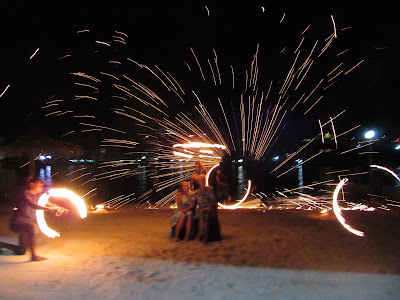Lamen Bay on Epi
Island served as a one-night stopover on our way north two months
ago, but we returned to spend a couple of days there on our way back
to Port Vila. It’s a spot well known for its resident turtle
population and frequent visits by a dugong.
Sure enough, the
turtles were easy to find—and they were unafraid, munching
leisurely on sea grass as we floated above them. There was also some
first-rate snorkeling, with attractive coral formations and a huge
array of colorful fish very near our boat.
 |
Unfortunately, our
timing was poor for the dugong. While we were there, one patrol boat
and four cargo ships came in and out of the bay, the cargo ships’
activities amplified by the large number of small boats speeding back
and forth with supplies. Things finally quieted down the afternoon we
left and the dugong returned, but no matter how far we swam, it was a
wild dugong chase; we got to see a face and flippers from a distance,
but didn’t get to float over him. Though we could probably have
been successful the next day, a change in the weather meant we had to
head south while we had a chance.
Ah well, it was
worth a try!
 |
| I would have preferred a photo of a dugong in this space, but the cargo ships are pretty interesting too! |
So we are now near
the end of our long loop around Vanuatu’s many islands, having
arrived back at Efate Island. Before going into Port Vila, we spent a
few final days in nearby Havannah Harbor, catching up on some
maintenance in peaceful anchorages there.
Our final
instrumental interlude included a special treat: the village at our last
anchorage was very musical. They had a washtub bass (large plastic
tub outfitted with a stick and a cord) and a small ukulele; people
took turns playing those instruments, and when they weren’t
playing, they were improvising clapped rhythms and singing their
hearts out. We played for each other, and jammed together in our style and theirs. What a fun finale!
Then, a truly Grand
Finale.
We made reservations
at a beach restaurant very near Second Wind
in Port Vila to celebrate our 43rd anniversary,
noticing they made a note of the special occasion. When we arrived,
they had set up a beautiful table just for us—a lovely gesture. But
we were astounded when they seated us in the middle of the evening’s
entertainment, a spectacular fire show! It was a celebration beyond
anything we could have imagined, and a sensational way to bring our
adventures in this phenomenal country to a close.
How to leave
Vanuatu? How to say goodbye to a country so full of gorgeous places,
exciting activities, and fascinating customs?
More than anything,
we will miss the people. Ten years ago a United Nations study
proclaimed the ni-Vans are the happiest people in the world—and
that must still be true. We received the warmest welcomes possible and
made friends everywhere we went; the closeness felt extraordinary.
Magic lives on in
Vanuatu!






















































